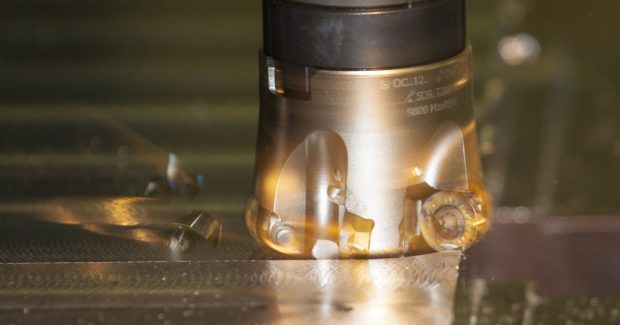Three Trends to Watch in Metalworking
Take a closer look at some of the steps that shops are taking to remain competitive in an increasingly high-tech, globalized industry; what obstacles they’re facing; and how they’re using technology to work smarter, better, and faster.
Posted: September 25, 2018
Business is booming at North American metalworking plants, where a robust construction market and healthy economy is keeping work pipelines full and bottom lines healthy. Having endured the Great Recession years and the economic downturn, the modern-day metalworking company has more work than it can handle, an ample customer base, and good prospects for the future over the next few years. For this year’s Metalworking Industry Report, we conducted hundreds of 20-minute online surveys with key stakeholders in the metalworking industry, reporting their perceptions of current business conditions, key challenges they’re facing, and the changes that are impacting individual companies within the industry. For this year’s survey, our customers described the steps their businesses are taking to remain competitive in an increasingly high-tech, globalized industry; what obstacles they’re dealing with on the road to success; and how they’re leveraging technology to work smarter, better, and faster. Here are the current, emerging, and future metalworking industry trends that respondents shared:
TREND 1: BUSINESS IS STRONG, BUT NEW WORK ALSO BRINGS NEW CHALLENGES
Operating in a robust economy where both commercial and residential construction activity are at all-time highs, metalworking companies are tapping into new opportunities to grow their bottom lines and seeing the results of their efforts. Economic activity in the manufacturing sector (including fabricated metal manufacturing) expanded in July, and the overall economy grew for the 111th consecutive month, according to Institute for Supply Management. This year’s Metalworking Industry Report also highlighted business challenges like fluctuating raw material costs, an aging workforce, overseas competition, and changing governmental regulations as the primary issues that metalworking firms are concerned about. These issues present a mix of challenges and opportunities for companies, many of which are turning to innovative labor recruitment efforts, advanced technology, and other strategies to succeed in the current business environment.
TREND 2: TIGHT LABOR CALLS FOR MORE CREATIVE RECRUITING AND RETENTION STRATEGIES
The good news is that work pipelines are ample and continuing to grow. The not-so-good news is that this is happening at a time when skilled labor is getting harder to find. So while new projects open up expanded opportunities, many of those companies are now taking a closer look at how to find the help and support that they need to complete those projects. As with most other industries, metalworking is using creative employee recruiting and retention strategies in 2018. That’s because as workers retire, filling the gaps they leave behind isn’t getting any easier. Currently, 59 percent of metalworking firms said they’re having a hard time finding and keeping qualified labor, and 45 percent are struggling with employee competency levels.
To offset these and other labor-related issues, 58 percent of metalworking companies have employee development programs that are focused on creating employee recruitment, development, and training programs – all of which they expect to become even more important in the future. Currently, 38 percent of companies use manager/supervisor training; 28 percent are using employee bonuses or profit sharing; and 28 percent are adding staff. Of those companies that are using these strategies, all feel that the steps will have a moderate positive impact on their operations over the next three years. Other strategies include the development of apprenticeship programs (21 percent are using them), college/tech school partnerships (21 percent), and staff reduction (17 percent). Combined, these approaches are helping the metalworking industry fill open positions while also ensuring that their current labor forces stay in place.
TREND 3: METALWORKING IS ADVANCING TOWARD INDUSTRY 4.0
Advanced technology continues to play a major role in the Industry 4.0 movement, which finds more and more manufacturers utilizing connected, automated systems to run their operations. According to the survey, keeping pace with these technological changes is “somewhat challenging” for 48 percent of metalworking firms, 44 percent of which say the cost of the new technology presents a challenge to their budgets. The types of technology currently deployed at metalworking firms is both wide and varied, and it’s helping these companies work smarter, better, and faster. Currently, 17 percent of metalworking companies have high speed machining (HSM) programs in place while 5-axis/universal machining and multi-task equipment (e.g., twin turret, turn-mill) equipment is being used by 13 percent of firms, respectively. Ten percent of customers are using 3D/additive for prototyping while 5 percent are using it for product parts.
Over the next three years, survey respondents say their top initiatives will include rebuilding some existing equipment to original specifications to meet changing customer requirements; adding new processing equipment; diversifying their product lines; and utilizing stronger, more focused recruiting efforts. Other strategies that metalworking firms are using to optimize their practices include lean manufacturing processes (28 percent), production monitoring and planning systems (27 percent), ongoing improvement processes like Six Sigma (23 percent), and supplier/vendor optimization analysis (18 percent).
As the metalworking industry continues to work through some of the current industry challenges, it plans to leverage more advanced technology (sensors, Internet of Things, artificial intelligence) in order to maintain competitive advantage. Each new year brings a new set of challenges and opportunities for all manufacturing sectors, and metalworking will surely withstand – and prevail over – the challenges put in front of it while also benefiting from emerging opportunities.





